DNA: The Molecule of Life
Response to the following questions:
Part. 1: DNA is a polymer of nucleotides.
1. The molecule of heredity is .
2. Which of the following is used to construct a molecule of DNA?
A) Chromosomes
B) Nucleotides
C) Double helix
D) Carbohydrates
3. Complete the following diagram of a DNA molecule by filling in the complementary bases.
A
T
T
G
A
C
4. Match the following terms with their appropriate descriptions: double helix, nucleic acid, nucleotide, backbone.
A) Molecules that contain information to make proteins
B) Consists of a base, five-carbon sugar, and a phosphate
C) Structure of a double-stranded molecule of DNA
D) Identical among all DNA molecules
5. Complete the following diagram that illustrates the structure of a nucleotide.

6. Overall, a molecule of DNA has a negative charge. Which component of DNA gives it this charge?
7. A gene is a specific section of DNA that contains the instructions to make a protein. If all molecules of DNA contain a phosphate group, a deoxyribose, and a base, propose an explanation for how the infor-mation to make a protein is coded within the DNA molecule.
8. If thymine makes up 20% of the bases in a DNA double helix, what percentage of the bases is guanine?
A) 80%
B) 60%
C) 30%
D) 20%
Part. 2: During DNA replication, a cell duplicates its chromosomes.
1. If one polynucleotide strand of DNA has ACTTGACTAGCTA as its sequence of bases, what would be the sequence of bases on the opposing strand?
2. True or false: DNA must be precisely copied prior to being passed on to the next generation. If false, make it a true statement.
3. The process by which a molecule of DNA is copied is known as .
4. Complete the following diagram, which illustrates the nature of DNA replication.
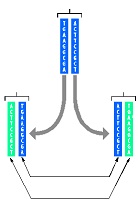
5. The following diagram uses colors to illustrate the replication of a chromosome. Use your knowledge of DNA replication to determine whether or not the illustration is accurate. If it is not accurate, brief
explain how to make it correct.
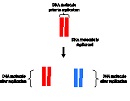
6. Place the following steps of DNA replication in the proper order: DNA fragments are fused together; double helix is pulled apart; new strands of DNA are synthesized.
7. A drug that inhibits DNA ligase but not DNA polymerase is added to a cell. Explain how DNA replica-tion would be affected as a result of this drug.
Part. 3: DNA directs the production of proteins via RNA.
1. True or false: Nucleic acids store the information to make carbohydrates. If false, make it a true statement.
2. Two types of nucleic acids that are found in all cells are and .
3. Which of the following is found in all nucleotides?
A) Phosphate group
B) Ribose
C) Deoxyribose
D) Uracil
4. Is the following diagram a nucleotide of DNA, RNA, or could it be either one? Briefly explain your answer.

5. Complete the following Venn diagram, which compares and contrasts DNA and RNA.
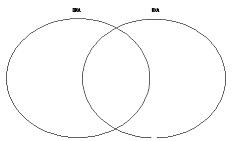
6. Certain viruses, like HIV, actually contain RNA. When a virus of this type takes over a host cell, it makes DNA from its RNA. The viral DNA is then used to make an RNA copy, which is used to make viral pro-teins. In all cells, the flow of genetic information is from DNA ? RNA ? proteins. Explain how this differs from viruses (which are not considered cells) like HIV.
7. You are a biochemist and have been given a test tube containing a small amount of nucleic acid. You have been asked to determine whether it is DNA or RNA. Which of the following would be a characteristic that indicates RNA? Hint: There may be more than one correct answer.
A) Presence of uracil, but no thymine
B) Presence of guanine, but no cytosine
C) Presence of phosphate, but no nitrogen
D) Presence of ribose, but no deoxyribose
Part. 4: Genetic information flows from DNA to RNA to protein.
1. True or false: DNA is directly responsible for producing your characteristics. If false, make it a true statement.
2. Correct the following: RNA →protein → DNA
3. Complete the following diagram, which represents the flow of genetic information in a cell.
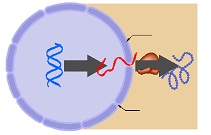
4. Translation converts the information stored in ____ into ______.
A) DNA; RNA
B) RNA; a protein
C) protein; DNA
D) protein; RNA
5. Briefly explain why you think "mRNA" is a good name for the RNA copy made from DNA.
6. Complete the following table, which compares transcription and translation.
Transcription Translation
Location
Description
7. If a strand of DNA has the sequence AAGCTC, transcription will result in which of the following?
A) Single RNA strand with the sequence TTCGAG
B) DNA strand with the sequence TTCGAG
C) Single RNA strand with the sequence UUCGAG
D) DNA strand with the sequence AAGCTC
8. A series of three nucleotides that specifies an amino acid is a(n) .
9. A student is given a sequence of DNA as follows: AACTAGCTAGCT, and is asked to provide the mRNA copy that would be made from that sequence during transcription. The student provides the fol-lowing sequence: TTGATCGATCGA. Is this the correct sequence? If not, explain why it is incorrect and fix it.
Part. 5: Transcription creates a molecule of RNA from a molecule of DNA.
1. is the process by which information stored in DNA is copied into mRNA.
2. List the following steps of transcription in order: RNA polymerase makes RNA; mRNA leaves the nuc-leus; RNA polymerase binds the promoter; RNA splicing.
3. Complete the following diagram, which illustrates the process of transcription.
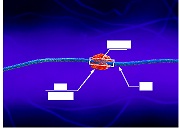
4. The template strand is the DNA strand directly used by the RNA polymerase to make the RNA copy. You are given the following mRNA sequence: AUGCUGAUU. Are you able to determine the sequence of bases on the DNA strand that was not transcribed? Briefly explain your answer either way.
5. A gene has a sequence of DNA in front of it that directs the RNA polymerase where to begin transcrip-tion. This sequence of DNA is the ______________________.
A) transcription
B) promoter
C) terminator
D) RNA splicing
6. You are a graduate student at the University of Iowa and working as a teaching assistant for a freshman introductory biology course. Two of your students have come to you with a question about the sequence of an mRNA transcribed from a gene. The original DNA sequence from which the mRNA was tran-scribed reads: TGACGATCGTA. The students were asked to provide the sequence of bases in the mRNA and came up with the following mRNA sequence: ACTGCTAGCAT. They are confused be-cause their answer does not match the answer in the book. Briefly explain the very common mistake they made and what the correct sequence would be.
7. True or false: The terminator is the sequence of DNA in front of the gene that tells the RNA polymerase where to begin transcription. If false, make it a correct statement.
8. List three ways in which mRNA is modified after transcription.
9. Are introns and exons found in DNA or RNA?
Part. 6: Translation involves the coordination of three kinds of RNA.
1. True or false: The process of translation occurs within the cytoplasm on a cellular structure known as the mitochondrion. If false, make it a true statement.
2. Which of the following RNA molecules is a component of ribosomes?
A) mRNA
B) rRNA
C) tRNA
D) All of the above
3. A set of three nucleotides that specifies an amino acid is called a(n) .
4. Which of the following RNA molecules is involved in the process of translation?
A) mRNA
B) rRNA
C) tRNA
D) All of the above
5. Complete the following diagram, which illustrates a ribosome.

6. Complete the following table, which compares the different kinds of RNA.
mRNA rRNA tRNA
Function
7. Briefly explain why a molecule of tRNA makes a good translator during the process of translation.
8. According to the table of the genetic code shown here, changing the second base of the codon
A) always changes the amino acid that is encoded.
B) never changes the amino acid that is encoded.
C) sometimes changes the amino acid that is encoded.
D) changes all of the above as noted.
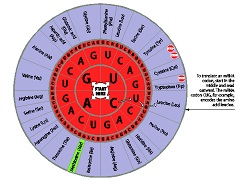
9. What codon does every mRNA molecule have in common? What amino acid begins every polypeptide?
10. Match the description to the molecule(s). Each choice should be used only once.
A. DNA
B. mRNA
C. tRNA
D. More than one of the above.
E. None of the above.
A molecule of this will always have an equal percentage of A and G, and an equal percentage of C and T
Has an anticodon and carries an amino acid
Serves as a messenger for taking genetic information from the nucleus to the cytoplasm
Is involved in the process of translation
Is a component of ribosomes
11. How many codons are in the following mRNA sequence?
AUGGGGCAGGUAUGA
12. Use the information from question 11 to determine how many amino acids would be in the polypeptide produced from that mRNA.
Part. 7: Translation creates a molecule of protein via the genetic code.
1. True or false: Ribosomes are part of the cytoplasm. If false, make it a true statement.
2. Place the following steps of translation in order: elongation, termination, and initiation.
3.. Translation takes place in the ______ on a _________.
A) nucleus; ribosome
B) cytoplasm; ribosome
C) nucleus; mitochondria
D) cytoplasm; lysosome
4. A drug that changes the AUG codon to UAC would most likely have what effect on translation? Be brief but specific in your answer.
5. If three DNA bases of the template strand are AGT, what is the anticodon of the tRNA that brings the amino acid?
A) UCA
B) TCU
C) AGU
D) TCA
6. Complete the following table, which compares the different stages of translation.
Initiation Elongation Termination
Description